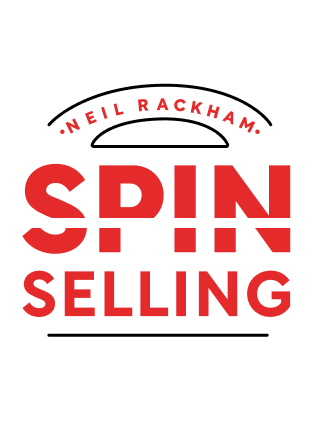

This article is an excerpt from the Shortform summary of "Spin Selling" by Neil Rackham. Shortform has the world's best summaries of books you should be reading.
Like this article? Sign up for a free trial here .
What are the SPIN selling skills, and why do you need them? How do you practice SPIN selling skills?
Once you start learning about the SPIN selling method, the next step is to work on your SPIN selling skills. You can use the following exercises to hone them.
The SPIN Model in Action: Top SPIN Selling Skills
The SPIN sales model is effective because it guides reps to ask questions that are important and relevant to the customer, as opposed to focusing on whether questions are open or closed. It moves the customer through a naturally unfolding process of uncovering and developing implied needs, and then evolving them into explicit needs. That way, you’re always working on improving your SPIN selling skills.
Here’s a summary showing the flow:
- The seller asks situation questions to understand the buyer’s context, leading to
- problem questions that help the buyer uncover implied needs,
- which the seller develops through implication questions that emphasize the magnitude of the problem,
- leading the buyer to state explicit needs,
- to which the seller responds with need-payoff questions,
- which allow the buyer to identify benefits, which contribute strongly to sales success.
The sequence may vary at times. For instance:
- A customer may start by stating an explicit need, and you can ask need-payoff questions immediately to get her to identify the benefits of your solution.
- You might ask a situation question to get more information while discussing problems or implications.
But most of the time, sales calls follow the SPIN sequence.
In a nutshell, research indicates that successful salespeople using the following SPIN selling skills:
- Ask situation questions, but not too many, to understand the customer situation.
- Ask problem questions to uncover implied needs.
- In smaller sales, reps may offer solutions next. But in larger sales, reps ask implication questions emphasizing the magnitude of the problem and the urgency of solving it.
- Reps ask need-payoff questions to get the buyer to identify benefits of the seller’s solution.
One of the best ways to practice SPIN selling skills is to practice asking SPIN selling questions. Follow these practice questions below.
SPIN Selling Skill: Practicing SPIN Questions
Using SPIN questions effectively requires planning:
- In planning a call, ask yourself, “What problems can I solve for this customer?”
- Write down at least three possible customer problems that your solution could address.
- Write down several problem questions you could ask to reveal each of the above problems.
Plan Implication Questions
Implication questions are difficult, if not impossible, to formulate on the fly, so plan them in advance. Remember, these questions contribute strongly to sales success. Use your SPIN selling skills to plan implication questions:
- Write down a problem the customer may have.
- Write down potential consequences or effects the problem might have.
- For each consequence, write the question it suggests. For example, if the problem is a shortage of qualified people to do something, the implication questions might be whether the shortage will lead to the company incurring overtime costs, or to having difficulty filling vacancies.
Tips for Asking Need-Payoff Questions
Need-payoff questions are difficult for reps to get used to asking, despite the fact that, of all the SPIN questions, customers react to them most positively. Knowing how to ask these questions is one of your most important SPIN selling skills. Here are a few tips:
- Don’t ask need-payoff questions before you’ve developed the customer’s problems. Sometimes reps start a sales call with questions like, “If I could show you a faster way to handle your billing, would you be interested?” Feeling manipulated, the customer will respond defensively. You have to develop and magnify needs before asking need-payoff questions.
- Don’t ask need-payoff questions for which you don’t have the solution—that is, questions about a need your product or service doesn’t address. For instance, don’t ask why the customer needs to produce double-sided copies if your company’s machine only copies one side. You’ll succeed only in making a need you can’t address stronger.
- The time to ask a need-payoff question is when the customer reveals a need you can meet. However, at that point, many reps jump right into talking about their solution instead of letting customers identify how having a solution would help them.
Practicing Need-Payoff questions
You can improve your SPIN selling skills with practice and effort. Here’s a simple practice exercise:
1) Ask a friend or colleague to help you (he doesn’t need to know anything about selling).
2) Think of a need your friend has—for instance, choosing a new car or vacation destination, or changing jobs.
3) Ask need-payoff questions to get the person talking about the benefits of addressing the need. For example, ask, “Why do you think it would be a good idea to get a new car?” “What features do you need that you don’t have now?”
You may be surprised to find that just practicing this exercise with someone can build the other person’s enthusiasm to the point of action. Need-payoff questions are that powerful.
Need-payoff questions are more generic than implication questions, which are focused on a customer’s business, so it’s useful to have a supply of need-payoff questions ready. Some examples are:
- Why is this important or why does it matter?
- How would that help the situation?
- Would it be useful if …?
- How else could this help you?
- How much would it save if….?
As you improve on the SPIN selling method, you can reference these exercises and examples at any time. You’ll see your SPIN selling skills improve dramatically.

———End of Preview———
Like what you just read? Read the rest of the world's best summary of Neil Rackham's "Spin Selling" at Shortform .
Here's what you'll find in our full Spin Selling summary :
- What the SPIN in SPIN Selling stands for
- How to demonstrate real value to the person you're selling to
- How to get commitment from your customer to close the sale fast






